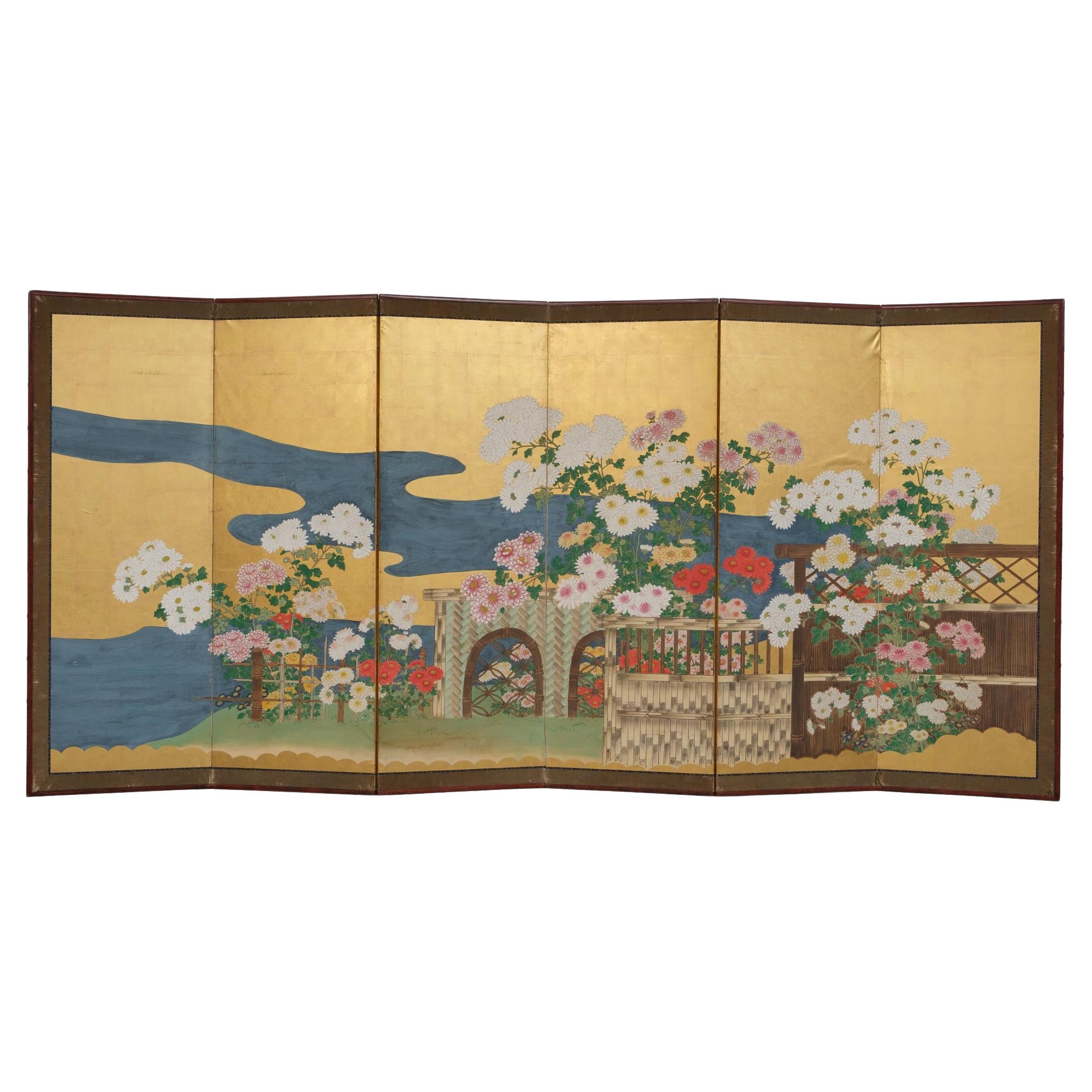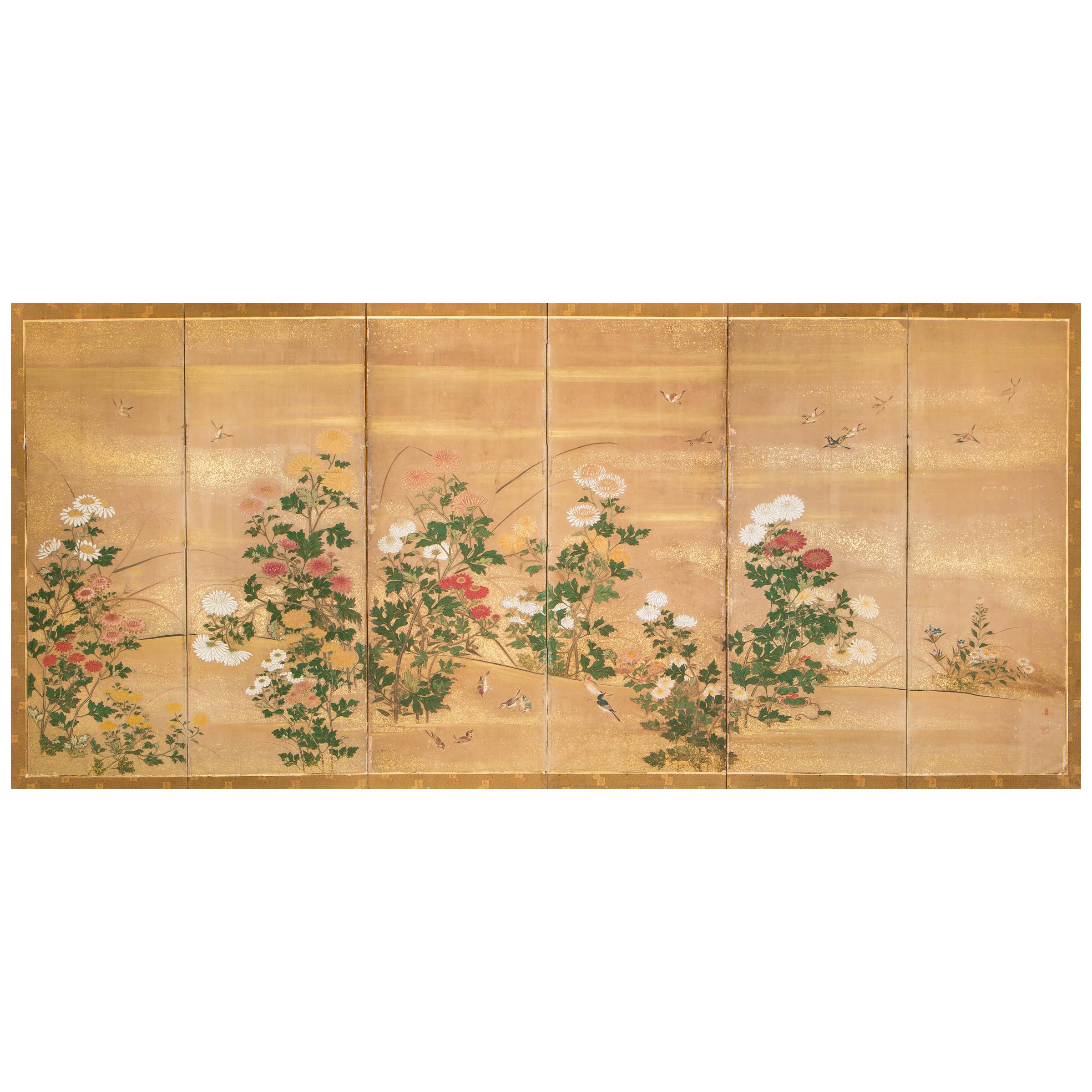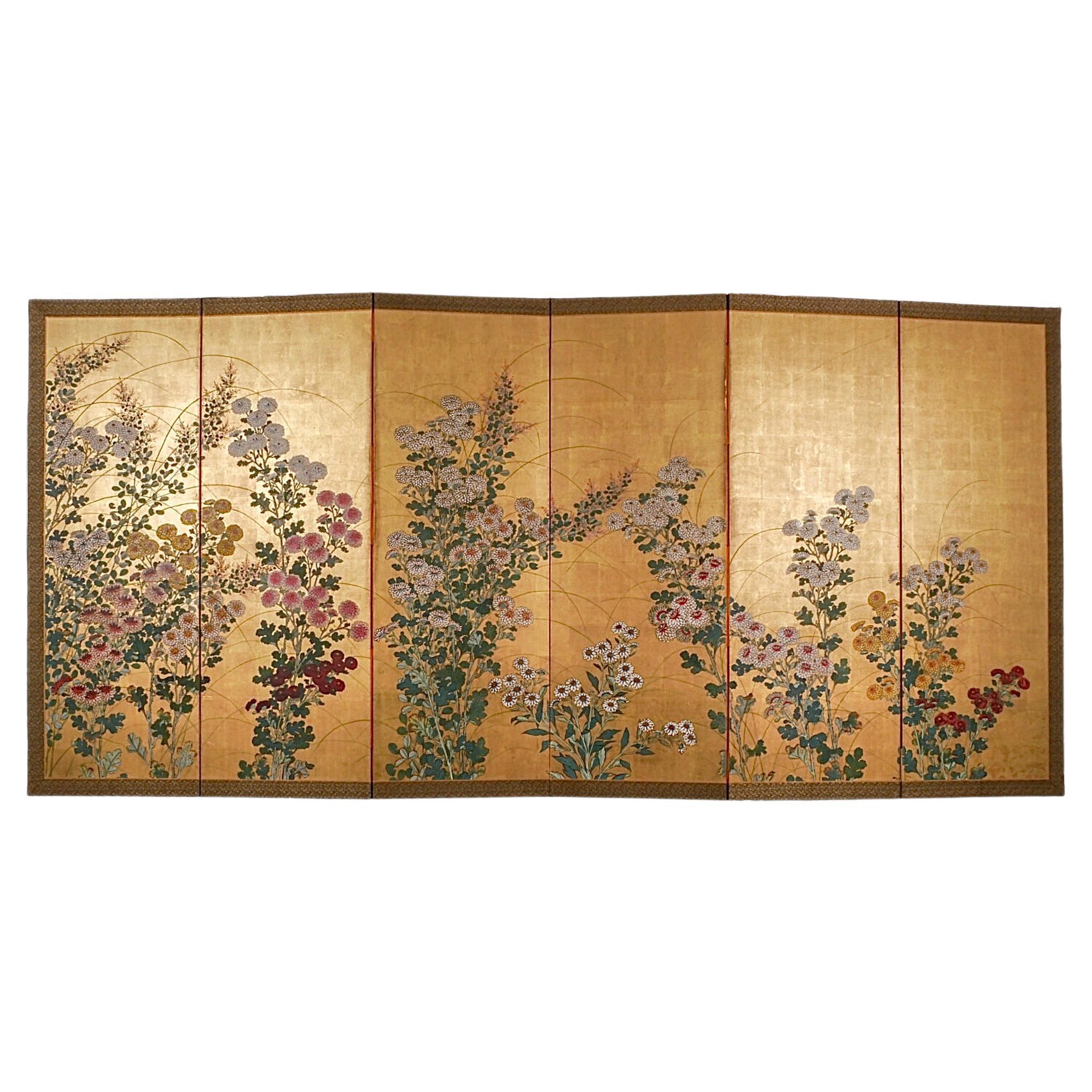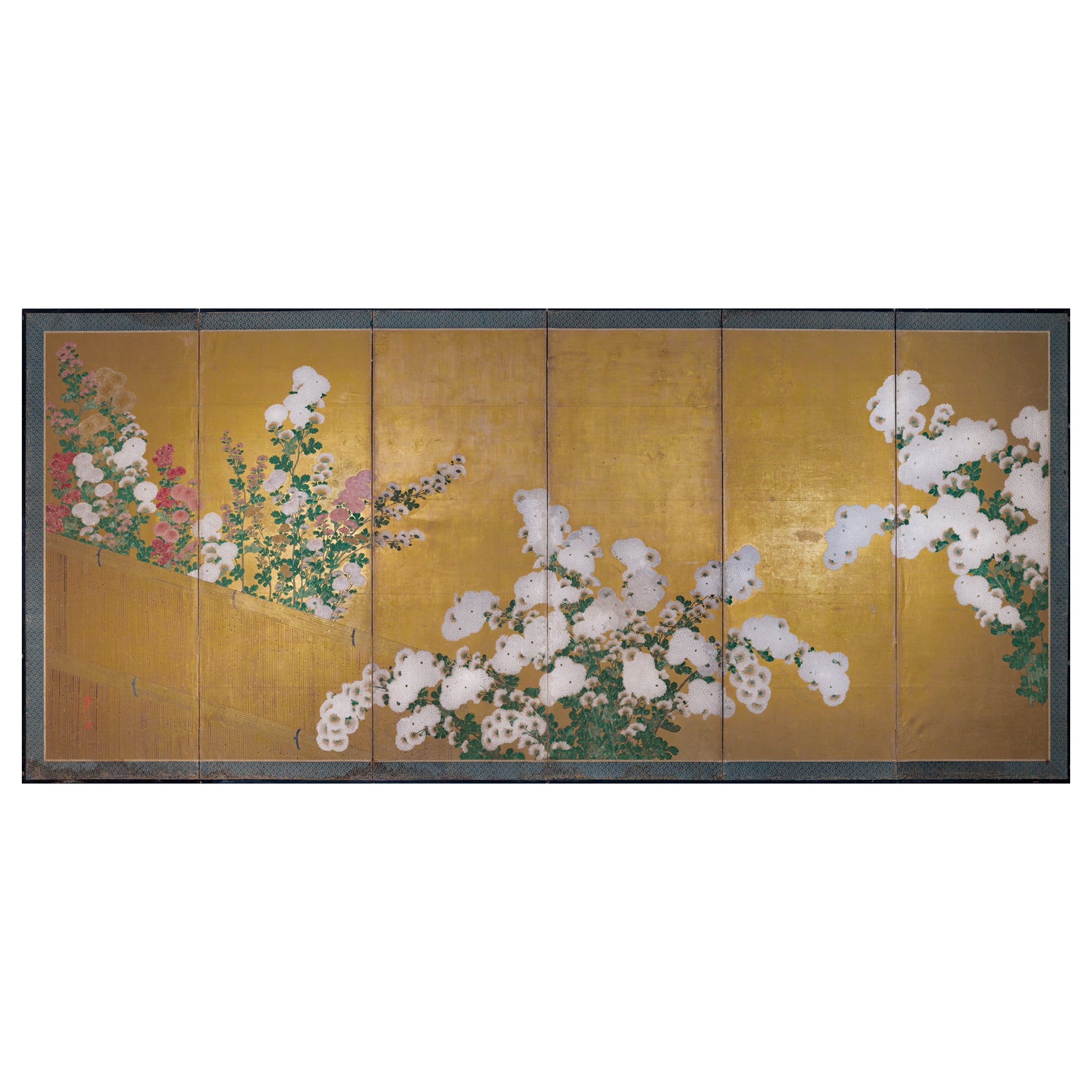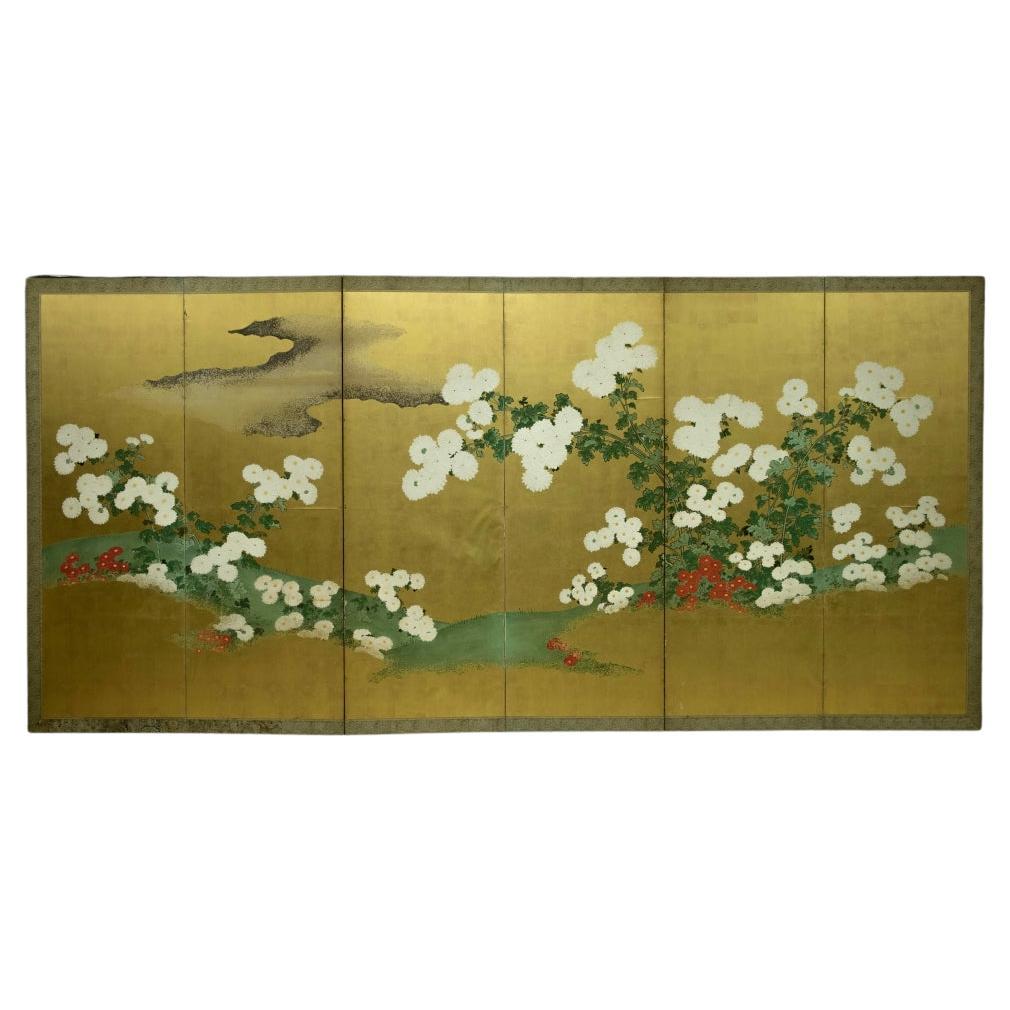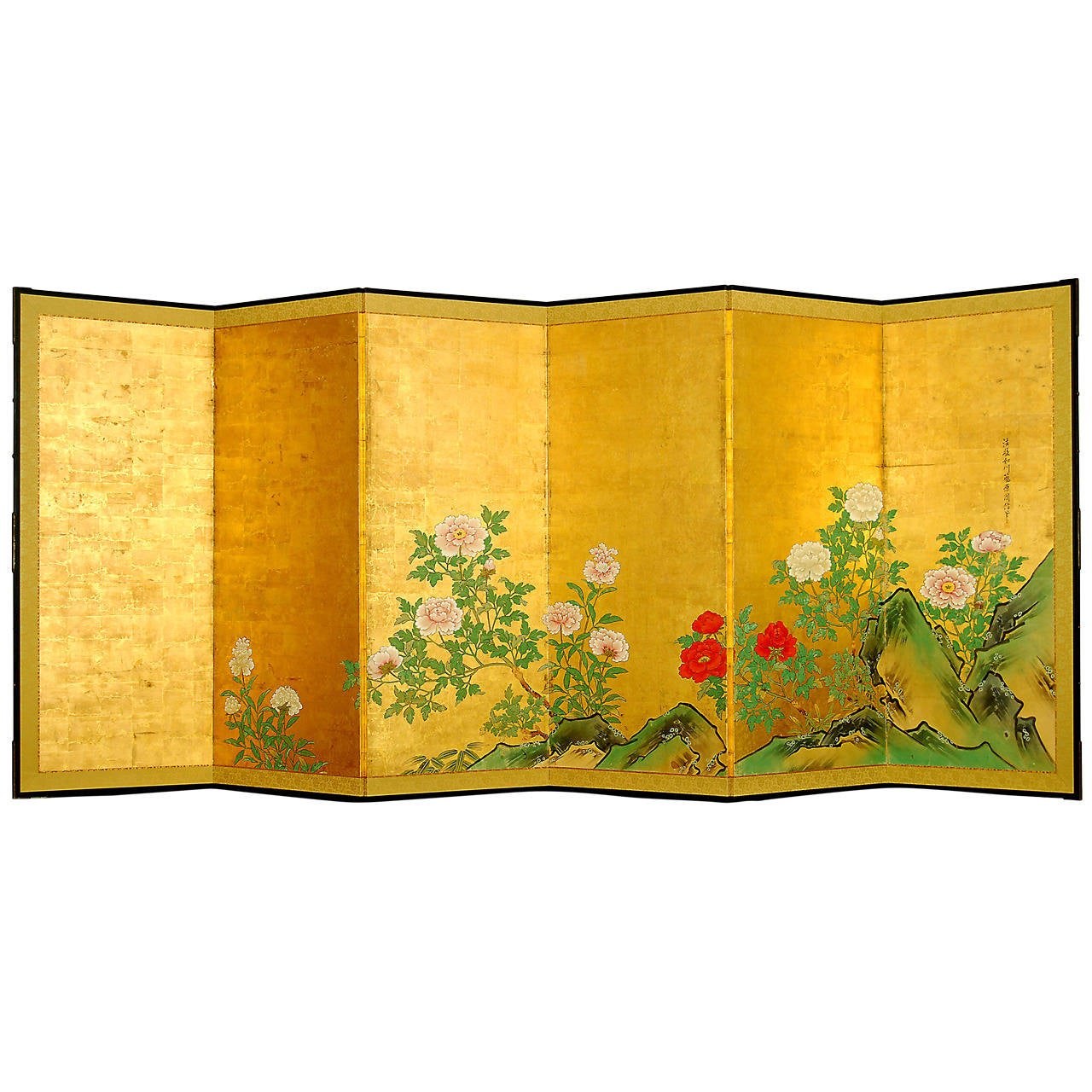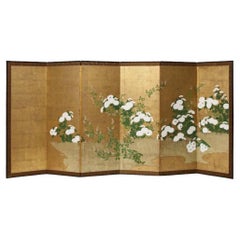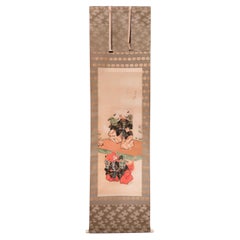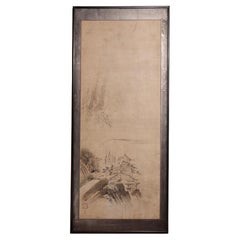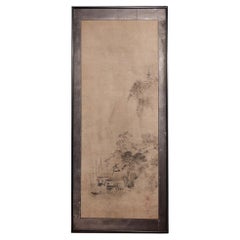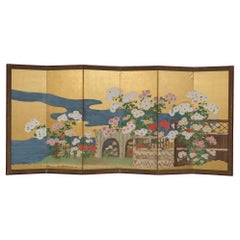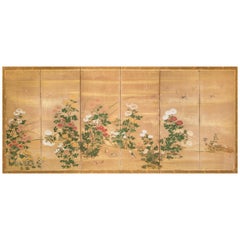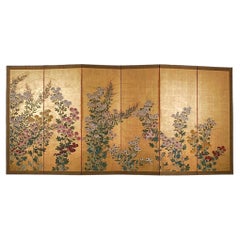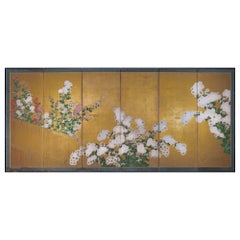Items Similar to “Kiku Byobu”, a six-panel chrysanthemum folding screen, Rinpa School
Want more images or videos?
Request additional images or videos from the seller
1 of 21
“Kiku Byobu”, a six-panel chrysanthemum folding screen, Rinpa School
$15,000
£11,286.11
€13,039.03
CA$21,198.92
A$23,017.90
CHF 12,189.66
MX$282,133.53
NOK 150,851.88
SEK 142,547.04
DKK 97,317.95
About the Item
“Kiku Byobu”, a six-panel chrysanthemum folding screen, Rinpa School, Meiji Period (1869-1912).
Painted with several variations of white moriage chrysanthemums interspersed with small crops of red and yellow chrysanthemums all growing behind two types of bamboo fencing, one rendered in relief and silvered, the other rendered in relief rendered in gold. The garden scene is complete with a dark blue river across three panels and mounds of green ground on each end, and gold flecked misty clouds on the paper background. The petals of the flowers and the surface of the fencing are built up in a relief of gofun and the colors used are mineral based pigments. The round red seal in the left lower corner reads as I'nen. Many I’nen seal works depict screen of flowers and plants. This circular seal was used on paintings during and after Sotatatsu’s lifetime (1570 - 1640) and generally are descended from the Tawaraya studio. The screen mounting consists of wood frames in six panels and traditional gold leaf paper hinges, a red lacquered frame with chased metal corners, silk kinran brocade surround and the verso in green raw silk on paper backing.
Condition: Minor cracks, splits, blemishes, wear and old repairs, generally stable and in good condition.
Measuring: Overall 67 inches high x 141 inches long. (170.2 x 358.2 cm), Folded: 67 inches x 24 inches x 4.25 inches(170.2 x 61 x 10.8 cm)
Weight: 27.5 lbs.
Meiji Period (1868-1912).
Provenance:
Mary and Melvin “Pete” Mark, Jr., Portland, Oregon
Collection of the Portland Art Museum, Portland, Oregon, Bequest of Mary and Pete Mark (acc. no. T2018.92.9).
Bonhams Los Angeles 26 June 2024, Asian Art Online, part of lot #415.
- Dimensions:Height: 67 in (170.18 cm)Width: 141 in (358.14 cm)Depth: 1 in (2.54 cm)
- Style:Meiji (Of the Period)
- Materials and Techniques:
- Place of Origin:
- Period:
- Date of Manufacture:1868-1912
- Condition:Repaired: Minor cracks, splits, blemishes, wear and old repairs, generally stable and in good condition. Wear consistent with age and use.
- Seller Location:Point Richmond, CA
- Reference Number:Seller: TM-UH901021stDibs: LU1778240476422
About the Seller
5.0
Platinum Seller
Premium sellers with a 4.7+ rating and 24-hour response times
Established in 1999
1stDibs seller since 2015
700 sales on 1stDibs
Typical response time: 2 hours
- ShippingRetrieving quote...Shipping from: Palm Springs, CA
- Return Policy
Authenticity Guarantee
In the unlikely event there’s an issue with an item’s authenticity, contact us within 1 year for a full refund. DetailsMoney-Back Guarantee
If your item is not as described, is damaged in transit, or does not arrive, contact us within 7 days for a full refund. Details24-Hour Cancellation
You have a 24-hour grace period in which to reconsider your purchase, with no questions asked.Vetted Professional Sellers
Our world-class sellers must adhere to strict standards for service and quality, maintaining the integrity of our listings.Price-Match Guarantee
If you find that a seller listed the same item for a lower price elsewhere, we’ll match it.Trusted Global Delivery
Our best-in-class carrier network provides specialized shipping options worldwide, including custom delivery.More From This Seller
View AllKiku to Hagi Byobu, Rinpa School Style, Edo Period.
Located in Point Richmond, CA
A Chrysanthemum and Bush Clover painting on gold leaf six-panel folding screen, painted with clusters of leafy green chrysanthemum plants with white blossoms having moriage relief petals of gofun growing amidst pink blossoming bush clover within a bunched bush clover garden fence rendered in lighter gold relief, all on a background entirely of rich gold leaf. These two flowers are symbolic of Japan and the autumn season. The classic patterned paper verso with a Naga Antiques...
Category
Antique Early 1800s Japanese Edo Paintings and Screens
Materials
Gold Leaf
Japanese Noh/Kabuki Shakkyo painting, Torii Kiyotada
Located in Point Richmond, CA
Japanese colors, gofun and metallics on silk painting of Noh/Kabuki Dancers, depicting two figures of actors dancing in the play Shakkyo portraying a pair of shishi (lions), one on a...
Category
Early 20th Century Japanese Meiji Paintings and Screens
Materials
Silk
Antique Japanese Suibokuga Landscape by Kano Tokinobu, 17th century.
Located in Point Richmond, CA
Antique Japanese Suibokuga Landscape by Kano Tokinobu, 17th century. A sumi-e ink on paper painting illustrating a rocky seaside landscape containing buildings, vegetation and ship masts. The painting with 3 vermillion seals of the artist in the lower left corner. Japanese dry mount paper on a wood frame with thin brocade border silver leafed surround and lacquered wood outer frame.
Condition: Lighter discoloration near the bottom of the painting, various paper restorations, other minor signs of age, wear, stains, otherwise fine condition.
Age: Painting Edo Period, circa 1670. Mounting circa 1985.
Image: 51-1/2 in. x 20-1/2 in. (131cm x 52cm)
Frame: 59-1/4 in. x 25-1/4 in. (150cm x 64cm)
Weight: 6 lbs.
Provenance:
with Honeychurch Antiques...
Category
Antique 1670s Japanese Edo Paintings and Screens
Materials
Paper
Antique Japanese Suibokuga Landscape by Kano Tokinobu, 17th century.
Located in Point Richmond, CA
Antique Japanese Suibokuga Landscape by Kano Tokinobu. 17th century.
A sumi-e ink on paper painting illustrating an ethereal mountainous landscape at the seashore containing buildings, trees, birds and ship masts. 3 vermillion seals of the artist in the lower right hand corner. Japanese dry mount paper on a wood frame with thin brocade border silver leafed surround and lacquered wood outer frame.
Condition: Minor signs of age, wear, otherwise fine condition.
Age: Painting Edo Period, circa 1670. Mounting circa 1985.
Image: 51-1/2 in. x 20-1/2 in. (131cm x 52cm)
Frame: 59-1/4 in. x 25-1/4 in. (150cm x 64cm)
Weight: 6 lbs.
Provenance:
with Honeychurch Antiques...
Category
Antique 1670s Japanese Edo Paintings and Screens
Materials
Paper
Japanese ink on paper painting of Plum Blossoms, Tani Buncho
Located in Point Richmond, CA
Japanese ink on paper painting of Plum Blossoms and Poem, scroll mounting, signature & single seal: Tani Buncho (1763 - 1840). A famous and prol...
Category
Antique 19th Century Japanese Meiji Paintings and Screens
Materials
Paper
Antique Japanese Suibokuga Sage by Kano Tokinobu, 17th century.
Located in Point Richmond, CA
Antique Japanese Suibokuga Sage Painting by Kano Tokinobu, 17th century. A sumi-e ink on paper painting illustrating an acolyte at a riverbank. The image of the standing Chinese figure with elongated earlobes (a symbol of enlightenment), hair tied back in a kerchief and long beard, holds a large fan in his left hand to his right shoulder. The long robes are windswept with water curls about the figures feet. The painting with 3 vermillion seals of the artist in the lower left corner. Japanese dry mount paper on a wood frame with thin brocade border silver leafed surround and lacquered wood outer frame.
Condition: Paper restoration on center, a quarter of an inch of the left edge of the painting is added, other minor signs of age, wear, stains and repairs overall fine condition.
Age: Painting Edo Period, circa 1670. Mounting circa 1985.
Image: 51-1/2 in. x 20-1/2 in. (131cm x 52cm)
Frame: 59-1/4 in. x 25-1/4 in. (150cm x 64cm)
Weight: 6lbs.
Provenance:
with Honeychurch Antiques...
Category
Antique 1670s Japanese Edo Paintings and Screens
Materials
Paper
You May Also Like
Large Japanese 6-panel byôbu 屏風 (folding screen) with chrysanthemum garden
Located in Amsterdam, NL
A very colourful and captivating large six-panel byôbu (folding screen) with a refined continuous painting of a luscious flower garden filled with many different types of chrysanthemums (kiku), next to a winding river.
This multi-coloured painting is set on a shiny gold-leaf background, and the chrysanthemum flowers are painted by using shell paste (gofun) in low relief.
Several clutches with a great variety of chrysanthemum flowers are in full bloom and they each show their unique form and colour. Varying from white, red, yellow and pink. The flowers bloom all around and on different kinds of bamboo fences and trellises.
In Japan chrysanthemums are believed to represent happiness, love, longevity and joy.
The panels are surrounded by two silk borders, a thin black one, and a wide brown one. The screen is protected by a black and red negoro’nuri...
Category
Antique Late 19th Century Japanese Paintings and Screens
Materials
Gold Leaf
Japanese Six-Panel Screen, Chrysanthemums
Located in Hudson, NY
Japanese six-panel screen: Chrysanthemums, Edo period (circa 1800) painting of a variety of chrysanthemums in a garden landscape, with sparrows. Mineral p...
Category
Antique Early 1800s Japanese Edo Paintings and Screens
Materials
Gold Leaf
Japanese Six-Panel Screen Byobu With Chrysanthemums And Autumn Grass and Flower
Located in Torino, IT
The 19th Century Six-Panel Japanese folding screen "Byōbu" usually used in the most important Japanese house to stop wind and also to separate different space of the same big room de...
Category
Antique Mid-19th Century Japanese Edo Paintings and Screens
Materials
Gold Leaf
Japanese Six Panel Screen by Garden’s Edge
Located in Hudson, NY
Edo period (18th century) painting of a flowing array of various types of chrysanthemums painted on beautifully faceted heavy gold leaf and behind afinely painted fence. Petals of th...
Category
Antique 18th Century Japanese Paintings and Screens
Materials
Gold
Late Edo Period Rinpa School Chrysanthemum Blossom Screen
By Rimpa School
Located in Fukuoka, JP
Late Edo Period Rinpa School Chrysanthemum Blossom Screen
Period: late Edo, early 19th century
Size: 364 x 172 cm (143 x 67 inches)
SKU: PTA13
This exquisite late Edo period Rinpa ...
Category
Antique 18th Century Japanese Edo Paintings and Screens
Materials
Paper
Antique Japanese Six-Panel Screen by Kano Chikanobu "Shushin"
Located in Prahran, Victoria
Late 17th century Kano school peony landscape screens. Both screens signed: Hogan Josen Fujiwara Chikanobu Hitsu - Kano Chikanobu (Shushin) (1660 - 1728...
Category
Antique Early 18th Century Japanese Edo Paintings and Screens
Materials
Gold Leaf
More Ways To Browse
Antique Chrysanthemum
Antique Folding Screen
Painted Folding Screen
Used Fencing
Antique Oregon
Chrysanthemum Japanese
Japanese 19th Century Meiji Period Silk Painting
19th Century Japanese Lacquer Screen
Antique Asian Folding Screen
Japanese Screens Byobu
Antique Fencing
Byobu Japanese Screen Painting
Six Panel Byobu
Japanese Screen Chrysanthemums
Japanese Screens Six Fold
Rinpa School
Japanese Screen Rinpa
Antique Brass Painting
